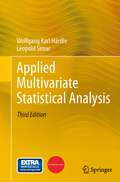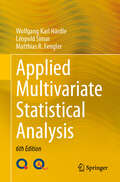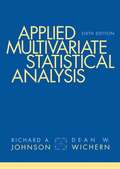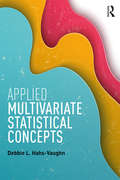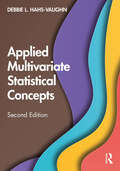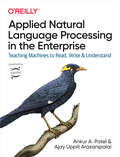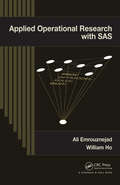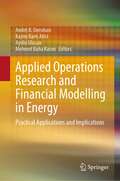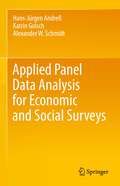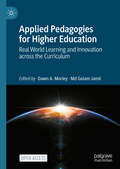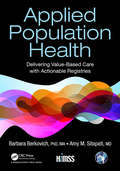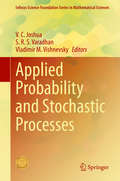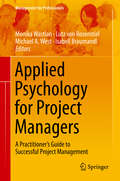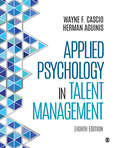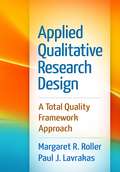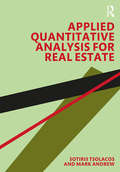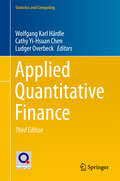- Table View
- List View
Applied Multivariate Statistical Analysis
by Wolfgang Karl Härdle Léopold SimarMost of the observable phenomena in the empirical sciences are of a multivariate nature. In financial studies, assets are observed simultaneously and their joint development is analysed to better understand general risk and to track indices. In medicine recorded observations of subjects in different locations are the basis of reliable diagnoses and medication. In quantitative marketing consumer preferences are collected in order to construct models of consumer behavior. The underlying data structure of these and many other quantitative studies of applied sciences is multivariate. Focusing on applications this book presents the tools and concepts of multivariate data analysis in a way that is understandable for non-mathematicians and practitioners who need to analyze statistical data. The book surveys the basic principles of multivariate statistical data analysis and emphasizes both exploratory and inferential statistics. All chapters have exercises that highlight applications in different fields.The third edition of this book on Applied Multivariate Statistical Analysis offers the following new featuresA new Chapter on Regression Models has been addedAll numerical examples have been redone, updated and made reproducible in MATLAB or R, see www.quantlet.org for a repository of quantlets.
Applied Multivariate Statistical Analysis
by Wolfgang Karl Härdle Léopold Simar Matthias R. FenglerNow in its sixth edition, this textbook presents the tools and concepts used in multivariate data analysis in a style accessible for non-mathematicians and practitioners. Each chapter features hands-on exercises that showcase applications across various fields of multivariate data analysis. These exercises utilize high-dimensional to ultra-high-dimensional data, reflecting real-world challenges in big data analysis. For this new edition, the book has been updated and revised and now includes new chapters on modern machine learning techniques for dimension reduction and data visualization, namely locally linear embedding, t-distributed stochastic neighborhood embedding, and uniform manifold approximation and projection, which overcome the shortcomings of traditional visualization and dimension reduction techniques. Solutions to the book’s exercises are supplemented by R and MATLAB or SAS computer code and are available online on the Quantlet and Quantinar platforms. Practical exercises from this book and their solutions can also be found in the accompanying Springer book by W.K. Härdle and Z. Hlávka: Multivariate Statistics - Exercises and Solutions.
Applied Multivariate Statistical Analysis (6th Edition)
by Richard Arnold Johnson Dean W. WichernThis market leader offers a readable introduction to the statistical analysis of multivariate observations. Gives readers the knowledge necessary to make proper interpretations and select appropriate techniques for analyzing multivariate data. Starts with a formulation of the population models, delineates the corresponding sample results, and liberally illustrates everything with examples. Offers an abundance of examples and exercises based on real data. Appropriate for experimental scientists in a variety of disciplines.
Applied Multivariate Statistical Concepts
by Debbie L. Hahs-VaughnMore comprehensive than other texts, this new book covers the classic and cutting edge multivariate techniques used in today’s research. Ideal for courses on multivariate statistics/analysis/design, advanced statistics or quantitative techniques taught in psychology, education, sociology, and business, the book also appeals to researchers with no training in multivariate methods. Through clear writing and engaging pedagogy and examples using real data, Hahs-Vaughn walks students through the most used methods to learn why and how to apply each technique. A conceptual approach with a higher than usual text-to-formula ratio helps reader’s master key concepts so they can implement and interpret results generated by today’s sophisticated software. Annotated screenshots from SPSS and other packages are integrated throughout. Designed for course flexibility, after the first 4 chapters, instructors can use chapters in any sequence or combination to fit the needs of their students. Each chapter includes a ‘mathematical snapshot’ that highlights the technical components of each procedure, so only the most crucial equations are included. Highlights include: -Outlines, key concepts, and vignettes related to key concepts preview what’s to come in each chapter -Examples using real data from education, psychology, and other social sciences illustrate key concepts -Extensive coverage of assumptions including tables, the effects of their violation, and how to test for each technique -Conceptual, computational, and interpretative problems mirror the real-world problems students encounter in their studies and careers -A focus on data screening and power analysis with attention on the special needs of each particular method -Instructions for using SPSS via screenshots and annotated output along with HLM, Mplus, LISREL, and G*Power where appropriate, to demonstrate how to interpret results -Templates for writing research questions and APA-style write-ups of results which serve as models -Propensity score analysis chapter that demonstrates the use of this increasingly popular technique -A review of matrix algebra for those who want an introduction (prerequisites include an introduction to factorial ANOVA, ANCOVA, and simple linear regression, but knowledge of matrix algebra is not assumed) -www.routledge.com/9780415842365 provides the text’s datasets preformatted for use in SPSS and other statistical packages for readers, as well as answers to all chapter problems, Power Points, and test items for instructors ?
Applied Multivariate Statistical Concepts
by Debbie L. Hahs-VaughnThis second edition of Applied Multivariate Statistical Concepts covers the classic and cutting-edge multivariate techniques used in today’s research.Through clear writing and engaging pedagogy and examples using real data, Hahs-Vaughn walks students through the most used methods to learn why and how to apply each technique. A conceptual approach with a higher than usual text-to-formula ratio helps readers master key concepts so they can implement and interpret results generated by today’s sophisticated software. Additional features include examples using real data from the social sciences; templates for writing research questions and results that provide manuscript-ready models; step-by-step instructions on using R and SPSS statistical software with screenshots and annotated output; clear coverage of assumptions, including how to test them and the effects of their violation; and conceptual, computational, and interpretative example problems that mirror the real-world problems students encounter in their studies and careers. This edition features expanded coverage of topics, such as propensity score analysis, path analysis and confirmatory factor analysis, and centering, moderation effects, and power as related to multilevel modelling. New topics are introduced, such as addressing missing data and latent class analysis, while each chapter features an introduction to using R statistical software. This textbook is ideal for courses on multivariate statistics/analysis/design, advanced statistics, and quantitative techniques, as well as for graduate students broadly in social sciences, education, and behavioral sciences. It also appeals to researchers with no training in multivariate methods.
Applied Natural Language Processing in the Enterprise
by Ankur A. Patel Ajay Uppili ArasanipalaiNLP has exploded in popularity over the last few years. But while Google, Facebook, OpenAI, and others continue to release larger language models, many teams still struggle with building NLP applications that live up to the hype. This hands-on guide helps you get up to speed on the latest and most promising trends in NLP.With a basic understanding of machine learning and some Python experience, you'll learn how to build, train, and deploy models for real-world applications in your organization. Authors Ankur Patel and Ajay Uppili Arasanipalai guide you through the process using code and examples that highlight the best practices in modern NLP.Use state-of-the-art NLP models such as BERT and GPT-3 to solve NLP tasks such as named entity recognition, text classification, semantic search, and reading comprehensionTrain NLP models with performance comparable or superior to that of out-of-the-box systemsLearn about Transformer architecture and modern tricks like transfer learning that have taken the NLP world by stormBecome familiar with the tools of the trade, including spaCy, Hugging Face, and fast.aiBuild core parts of the NLP pipeline--including tokenizers, embeddings, and language models--from scratch using Python and PyTorchTake your models out of Jupyter notebooks and learn how to deploy, monitor, and maintain them in production
Applied Nonparametric Econometrics
by Daniel J. Henderson Christopher F. ParmeterThe majority of empirical research in economics ignores the potential benefits of nonparametric methods, while the majority of advances in nonparametric theory ignores the problems faced in applied econometrics. This book helps bridge this gap between applied economists and theoretical nonparametric econometricians. It discusses in depth, and in terms that someone with only one year of graduate econometrics can understand, basic to advanced nonparametric methods. The analysis starts with density estimation and motivates the procedures through methods that should be familiar to the reader. It then moves on to kernel regression, estimation with discrete data, and advanced methods such as estimation with panel data and instrumental variables models. The book pays close attention to the issues that arise with programming, computing speed, and application. In each chapter, the methods discussed are applied to actual data, paying attention to presentation of results and potential pitfalls.
Applied Operational Research with SAS
by Ali Emrouznejad William HoUsing a wide range of operational research (OR) optimization examples, Applied Operational Research with SAS demonstrates how the OR procedures in SAS work. The book is one of the first to extensively cover the application of SAS procedures to OR problems, such as single criterion optimization, project management decisions, printed circuit board as
Applied Operations Research and Financial Modelling in Energy: Practical Applications and Implications
by Mehmet Baha Karan André B. Dorsman Kazim Baris Atici Aydin UlucanThis book on Applied Operations Research and Financial Modelling in Energy (AORFME) presents several applications of operations research (OR) and financial modelling. The contributions by a group of OR and Finance researchers focus on a variety of energy decisions, presenting a quantitative perspective, and providing policy implications of the proposed or applied methodologies. The content is divided into three main parts: Applied OR I: Optimization Approaches, Applied OR II: Forecasting Approaches and Financial Modelling: Impacts of Energy Policies and Developments in Energy Markets. The book appeals to scholars in economics, finance and operations research, and to practitioners working in the energy sector. This is the eighth volume in a series of books on energy organized by the Centre for Energy and Value Issues (CEVI). For this volume, CEVI collaborated with Hacettepe University’s Energy Markets Research and Application Center. The previous volumes in the series are: Financial Aspects in Energy (2011), Energy Economics and Financial Markets (2012), Perspectives on Energy Risk (2014), Energy Technology and Valuation Issues (2015), Energy and Finance (2016), Energy Economy, Finance and Geostrategy (2018), and Financial Implications of Regulations in the Energy Industry (2020).
Applied Optimization in the Petroleum Industry
by Hesham K. AlfaresThe book addresses optimization in the petroleum industry from a practical, large-scale-application-oriented point of view. The models and techniques presented help to optimize the limited resources in the industry in order to maximize economic benefits, ensure operational safety, and reduce environmental impact. The book discusses several important real-life applications of optimization in the petroleum industry, ranging from the scheduling of personnel time to the blending of gasoline. It covers a wide spectrum of relevant activities, including drilling, producing, maintenance, and distribution. The text begins with an introductory overview of the petroleum industry and then of optimization models and techniques. The main body of the book details a variety of applications of optimization models and techniques within the petroleum industry.Applied Optimization in the Petroleum Industry helps readers to find effective optimization-based solutions to their own practical problems in a large and important industrial sector, still the main source of the world’s energy and the source of raw materials for a wide variety of industrial and consumer products.
Applied Panel Data Analysis for Economic and Social Surveys
by Katrin Golsch Hans-Jürgen Andreß Alexander W. SchmidtMany economic and social surveys are designed as panel studies, which provide important data for describing social changes and testing causal relations between social phenomena. This textbook shows how to manage, describe, and model these kinds of data. It presents models for continuous and categorical dependent variables, focusing either on the level of these variables at different points in time or on their change over time. It covers fixed and random effects models, models for change scores and event history models. All statistical methods are explained in an application-centered style using research examples from scholarly journals, which can be replicated by the reader through data provided on the accompanying website. As all models are compared to each other, it provides valuable assistance with choosing the right model in applied research. The textbook is directed at master and doctoral students as well as applied researchers in the social sciences, psychology, business administration and economics. Readers should be familiar with linear regression and have a good understanding of ordinary least squares estimation.
Applied Pedagogies for Higher Education: Real World Learning and Innovation across the Curriculum
by Dawn A. Morley Md Golam JamilThis open access book critiques real world learning across both the curriculum and extracurricular activities. Drawing on disciplines as diverse as business, health, fashion, sociology and geography, the editors and authors employ a cross-disciplinary approach to examine how this concept is being applied in higher education. Divided into three parts, the authors and contributors analyse broader applications of real world learning, student experience of practicing in a real world setting, and how learning strategies can be employed to engage students in real world learning. The editors and contributors provide up-to-date, cross-disciplinary and international insights into how real world learning could be integrated into the higher education curriculum to support effective, relevant and life-long learning for 21st century students.
Applied Population Health: Delivering Value-Based Care with Actionable Registries (HIMSS Book Series)
by Barbara Berkovich, PhD, MA Amy Sitapati, MDElectronic Health Record (EHR) systems today provide increasing levels of clinical decision support and are the fulcrum for change for value-based healthcare delivery. Billions of dollars of government and insurer payments are dependent on evidence-based workflow design and quality report. In this context, quality measurement is no longer a retrospective exercise, but an essential prospective process embedded in clinical operations. Population health tools in the EHR enhance the efficiency and effectiveness of interventions thus improving the quality of care at lower cost. Population health methods are effective in ensuring that the right patient receives the right care at the right time. This book provides a clear framework for design, implementation, and monitoring of innovative population health tools to accelerate measurable improvements in care delivery. Key benefits for readers include conceptual framework, team approach, and technical insights that result in improved patient care, improved performance on quality measures and increased revenue from quality performance incentives and risk-based contracts. This is also a practice guide to the healthcare professionals many roles who are eager to build or improve population health programs with the goal of delivering high quality value-based care.
Applied Probability and Stochastic Processes
by Frank BeicheltApplied Probability and Stochastic Processes, Second Edition presents a self-contained introduction to elementary probability theory and stochastic processes with a special emphasis on their applications in science, engineering, finance, computer science, and operations research. It covers the theoretical foundations for modeling time-dependent random phenomena in these areas and illustrates applications through the analysis of numerous practical examples. The author draws on his 50 years of experience in the field to give your students a better understanding of probability theory and stochastic processes and enable them to use stochastic modeling in their work. New to the Second Edition Completely rewritten part on probability theory—now more than double in size New sections on time series analysis, random walks, branching processes, and spectral analysis of stationary stochastic processes Comprehensive numerical discussions of examples, which replace the more theoretically challenging sections Additional examples, exercises, and figures Presenting the material in a student-friendly, application-oriented manner, this non-measure theoretic text only assumes a mathematical maturity that applied science students acquire during their undergraduate studies in mathematics. Many exercises allow students to assess their understanding of the topics. In addition, the book occasionally describes connections between probabilistic concepts and corresponding statistical approaches to facilitate comprehension. Some important proofs and challenging examples and exercises are also included for more theoretically interested readers.
Applied Probability and Stochastic Processes (Infosys Science Foundation Series)
by Vladimir M. Vishnevsky V. C. Joshua S. R. S. VaradhanThis book gathers selected papers presented at the International Conference on Advances in Applied Probability and Stochastic Processes, held at CMS College, Kerala, India, on 7–10 January 2019. It showcases high-quality research conducted in the field of applied probability and stochastic processes by focusing on techniques for the modelling and analysis of systems evolving with time. Further, it discusses the applications of stochastic modelling in queuing theory, reliability, inventory, financial mathematics, operations research, and more. This book is intended for a broad audience, ranging from researchers interested in applied probability, stochastic modelling with reference to queuing theory, inventory, and reliability, to those working in industries such as communication and computer networks, distributed information systems, next-generation communication systems, intelligent transportation networks, and financial markets.
Applied Psychology Readings: Selected Papers from the Singapore Conference on Applied Psychology 2022
by Lee-Ming Tan Peter MacaulayThis book is a compilation of the best papers presented at the 2022 edition of the Singapore Conference of Applied Psychology (SCAP), led by East Asia Research in Singapore in collaboration with the University of Derby in the UK and the Singapore University of Technology and Design. Chapters include research conducted by experts in the field of applied psychology from the Asia-Pacific region, and cover areas such as community and environmental psychology, psychotherapy and counseling, health, child and school psychology, and gender studies. The volume is of interest to educators, psychology researchers and practicing counselors.
Applied Psychology for Project Managers: A Practitioner's Guide to Successful Project Management (Management for Professionals)
by Michael A. West Monika Wastian Isabell Braumandl Lutz RosenstielThis book offers an essential manual for project managers, project management offices (PMO's), trainers and consultants, addressing the psychological side of project management. Written by leading scholars in organizational psychology and by top experts in project management, it covers all major psychological topics that are key to project success. The book features dedicated chapters on leadership and teamwork, including virtual and intercultural cooperation, commitment and motivation of project teams. It adds a psychological perspective to personnel management, decision-making, information and knowledge management and communication in project work. Power, influencing tactics and other aspects of stakeholder management are covered, as well as project coaching, innovation and creativity, self-management and the management of conflicts, risks and crises.
Applied Psychology in Talent Management
by Herman Aguinis Professor Wayne F. CascioIn Applied Psychology in Talent Management, world-renowned authors Wayne F. Cascio and Herman Aguinis provide the most comprehensive, future-oriented overview of psychological theories and how they impact people decisions in today’s ever-changing workplace. Taking a rigorous, evidence-based approach, the new Eighth Edition includes more than 1,000 new citations from over 20 top-tier journal articles. The authors uniquely emphasize the latest developments in the field—all in the context of historical perspectives. Integrated coverage of technology, strategy, globalization, and social responsibility throughout the text provides students with a holistic view of the field and equips them with the practical tools necessary to create productive, enjoyable work environments.
Applied Psychology in Talent Management
by Herman Aguinis Professor Wayne F. CascioIn Applied Psychology in Talent Management, world-renowned authors Wayne F. Cascio and Herman Aguinis provide the most comprehensive, future-oriented overview of psychological theories and how they impact people decisions in today’s ever-changing workplace. Taking a rigorous, evidence-based approach, the new Eighth Edition includes more than 1,000 new citations from over 20 top-tier journal articles. The authors uniquely emphasize the latest developments in the field—all in the context of historical perspectives. Integrated coverage of technology, strategy, globalization, and social responsibility throughout the text provides students with a holistic view of the field and equips them with the practical tools necessary to create productive, enjoyable work environments.
Applied Psychology in Talent Management
by Wayne F. Cascio Herman AguinisIn the Ninth Edition of Applied Psychology in Talent Management, world-renown authors Wayne F. Cascio and Herman Aguinis provide the most comprehensive, future-oriented overview of psychological theories and how they impact people decisions in today′s workplace. Taking a rigorous, evidence-based approach, the new edition includes more than 750 new citations from top-tier journal articles. Integrated coverage of technology, strategy, globalization, and social responsibility throughout the text provides students with a holistic view of the field and equips them with the tools necessary to create productive, enjoyable work environments.
Applied Psychology in Talent Management
by Wayne F. Cascio Herman AguinisIn the Ninth Edition of Applied Psychology in Talent Management, world-renown authors Wayne F. Cascio and Herman Aguinis provide the most comprehensive, future-oriented overview of psychological theories and how they impact people decisions in today′s workplace. Taking a rigorous, evidence-based approach, the new edition includes more than 750 new citations from top-tier journal articles. Integrated coverage of technology, strategy, globalization, and social responsibility throughout the text provides students with a holistic view of the field and equips them with the tools necessary to create productive, enjoyable work environments.
Applied Public Relations: Cases in Stakeholder Management (Routledge Communication Series)
by Kathy Brittain Richardson Marcie HintonWith its practical orientation and scope, Applied Public Relations is the ideal text for any public relations case studies or public relations management course that places an emphasis on stakeholder groups. Through the presentation of current cases covering a wide variety of industries, locations, and settings, Kathy Richardson and Marcie Hinton examine how real organizations develop and maintain their relationships, offering valuable insights into business and organizational management practices. The book’s organization of case studies allows instructors to use the text in several ways: instructors can focus on specific stakeholders by using the chapters presented; they can focus on particular issues, such as labor relations or crisis management by selecting cases from within several chapters; or they can select cases that contrast campaigns with ongoing programs or managerial behaviors. A focus on ethics and social responsibility underlies the book, and students are challenged to assess the effectiveness of the practices outlined and understand the ethical implications of those choices. This Third Edition features: 25 new and current domestic and international case studies specifically chosen for their relevancy and relatability to students New "Professional Insights" commentaries where practitioners respond to a set of questions relating to their work Increased emphasis on ethics and social responsibility Fully enhanced companion website that is connected with the text, including a test bank and PowerPoint presentations for instructors, and chapter-specific discussion questions and additional readings for students
Applied Qualitative Research Design
by Paul J. Lavrakas Margaret R. RollerThis unique text provides a comprehensive framework for creating, managing, and interpreting qualitative research studies that yield valid and useful information. Examples of studies from a wide range of disciplines illustrate the strengths, limitations, and applications of the primary qualitative methods: in-depth interviews, focus group discussions, ethnography, content analysis, and case study and narrative research. Following a consistent format, chapters show students and researchers how to implement each method within a paradigm-neutral and flexible Total Quality Framework (TQF) comprising four interrelated components: Credibility, Analyzability, Transparency, and Usefulness. Unlike other texts that relegate quality issues to one or two chapters, detailed discussions of such crucial topics as construct validity, interresearcher reliability, researcher bias, and verification strategies are featured throughout. The book also addresses applications of the TQF to the writing, review, and evaluation of qualitative research proposals and manuscripts. Pedagogical Features: *Summary tables that highlight important content, such as the application of a method to vulnerable or hard-to-reach populations. *Case studies that illustrate TQF standards in practice for each method. *Guidelines for effective documentation (via thick descriptions) of each type of study. *End-of-chapter discussion topics, exercises, and suggested further reading and Web resources. *Chapters open with a preview and close with a bulleted summary of key ideas. *Extensive glossary.
Applied Quantitative Analysis for Real Estate
by Sotiris Tsolacos Mark AndrewTo fully function in today’s global real estate industry, students and professionals increasingly need to understand how to implement essential and cutting-edge quantitative techniques. This book presents an easy-to-read guide to applying quantitative analysis in real estate aimed at non-cognate undergraduate and masters students, and meets the requirements of modern professional practice. Through case studies and examples illustrating applications using data sourced from dedicated real estate information providers and major firms in the industry, the book provides an introduction to the foundations underlying statistical data analysis, common data manipulations and understanding descriptive statistics, before gradually building up to more advanced quantitative analysis, modelling and forecasting of real estate markets. Our examples and case studies within the chapters have been specifically compiled for this book and explicitly designed to help the reader acquire a better understanding of the quantitative methods addressed in each chapter. Our objective is to equip readers with the skills needed to confidently carry out their own quantitative analysis and be able to interpret empirical results from academic work and practitioner studies in the field of real estate and in other asset classes. Both undergraduate and masters level students, as well as real estate analysts in the professions, will find this book to be essential reading.
Applied Quantitative Finance (Statistics and Computing)
by Wolfgang Karl Härdle Cathy Yi-Hsuan Chen Ludger OverbeckThis volume provides practical solutions and introduces recent theoretical developments in risk management, pricing of credit derivatives, quantification of volatility and copula modeling. This third edition is devoted to modern risk analysis based on quantitative methods and textual analytics to meet the current challenges in banking and finance. It includes 14 new contributions and presents a comprehensive, state-of-the-art treatment of cutting-edge methods and topics, such as collateralized debt obligations, the high-frequency analysis of market liquidity, and realized volatility. The book is divided into three parts: Part 1 revisits important market risk issues, while Part 2 introduces novel concepts in credit risk and its management along with updated quantitative methods. The third part discusses the dynamics of risk management and includes risk analysis of energy markets and for cryptocurrencies. Digital assets, such as blockchain-based currencies, have become popular but are theoretically challenging when based on conventional methods. Among others, it introduces a modern text-mining method called dynamic topic modeling in detail and applies it to the message board of Bitcoins. The unique synthesis of theory and practice supported by computational tools is reflected not only in the selection of topics, but also in the fine balance of scientific contributions on practical implementation and theoretical concepts. This link between theory and practice offers theoreticians insights into considerations of applicability and, vice versa, provides practitioners convenient access to new techniques in quantitative finance. Hence the book will appeal both to researchers, including master and PhD students, and practitioners, such as financial engineers. The results presented in the book are fully reproducible and all quantlets needed for calculations are provided on an accompanying website. The Quantlet platform quantlet. de, quantlet. com, quantlet. org is an integrated QuantNet environment consisting of different types of statistics-related documents and program codes. Its goal is to promote reproducibility and offer a platform for sharing validated knowledge native to the social web. QuantNet and the corresponding Data-Driven Documents-based visualization allows readers to reproduce the tables, pictures and calculations inside this Springer book.
